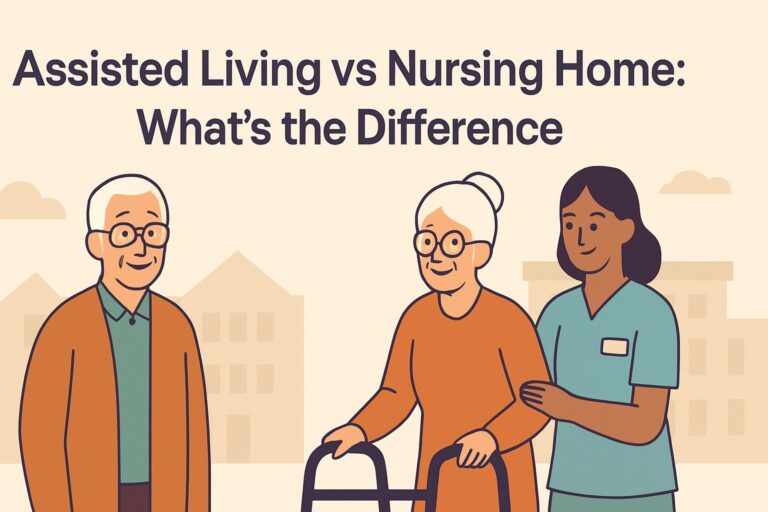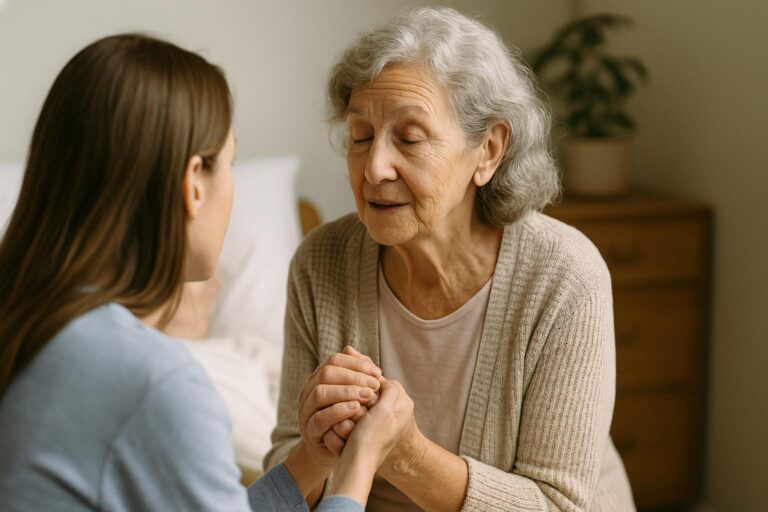When someone we love is nearing the end of their journey, the smallest changes can feel overwhelming.
You find yourself noticing every breath, every flutter of their fingers, every shift in their skin tone — and your heart aches with questions you don’t always know how to ask.
One of the more noticeable changes is mottled skin before death. It can look startling if you’re not expecting it — patches of purplish or reddish color, usually on the hands, feet, or legs. And if you’re like many families I’ve worked with over the years, the first time you see it, you might wonder: Is my loved one in pain? Is the end near? What should I do?
Take a deep breath.
Mottled skin is a normal part of the body’s natural process as it prepares to let go.
It’s not a sign of suffering — it’s the body working in its own quiet way.
In this guide, I’ll walk you through what mottled skin means, what to expect, and how you can offer comfort and presence through these precious final moments.
It won’t take away the sadness — but understanding can ease some of the fear, and it can help you stay present with the person you love most.
What is Mottled Skin?
Mottled skin or Livedo Reticularis is one of the ways the body gently signals that it’s winding down.
You’ll notice it as a patchy, sometimes web-like pattern — purples, reds, and blues that spread across the hands, feet, legs, or arms. It might look a little like marble under the skin.
What’s happening is simple, even though it feels anything but simple when you’re standing there looking at it:
As the heart gets weaker and circulation slows, blood doesn’t move through the body the way it used to. Instead of flowing easily to every corner, it pools, especially in the parts farthest from the heart — the toes, the fingers, the knees.
This pooling of blood under the skin creates that mottled, uneven look.
It’s important to know:
- Mottling doesn’t hurt. It’s not causing your loved one any pain.
- It’s not sudden. It usually comes on gradually, giving you time to notice and adjust.
- It’s part of the body’s natural farewell.
In my years working with families, I’ve always found that once they understood what mottling was — and what it wasn’t — their fear lessened.
It’s not something to fight. It’s something to meet with love, patience, and presence.
Why Does Mottled Skin Occur Before Death?
Mottled skin happens because the body is doing exactly what it was designed to do when life is coming to a close — it’s conserving energy for the parts that matter most.
As the heart weakens, it naturally pulls back from trying to pump blood to every corner of the body.
Instead, it focuses on the vital organs — the brain, the heart itself, the lungs.
Circulation to the hands, feet, arms, and legs becomes slower and weaker. Without strong blood flow, the skin in those areas starts to change color and temperature.
Think of it like a home in winter: when there’s only a little firewood left, you heat just one room to stay warm. The body is doing something similar — concentrating its strength where it’s needed most.
Here’s the simple breakdown:
- Heart slows → blood flow drops.
- Blood pools → skin changes color.
- Body focuses → survival in the core.
It’s not a failure. It’s not the body “giving up.”
It’s the body taking care of itself, right up until the very end.
And it’s our role, as caregivers and loved ones, to honor that process — to walk alongside it with gentleness and grace.
When Does Mottling Happen in the Dying Process?
Mottled skin usually appears in the final hours or days before someone passes, but just like every life is unique, so is every goodbye.
For some, you may notice the first faint patches of discoloration a few days before death.
For others, it may happen more quickly — sometimes just in the last few hours.
A general guide:
- If mottling appears on the feet or lower legs, it often means death is approaching within hours to a couple of days.
- If mottling spreads upward toward the thighs or torso, that usually signals that time is very short — often just hours.
But let me be clear about something important:
There’s no precise clock.
Mottling is a signpost, not a stopwatch.
I always encourage families to think of it this way:
When you notice mottling, it’s time to gather close.
It’s time for final words, for holding hands, for sitting quietly beside them.
Not in fear — but in honor.
You’re not losing them in that moment — you’re accompanying them with love through their final, sacred stretch of the journey.
How Does Mottled Skin Look and Feel?
If you’ve never seen mottled skin before, it can be startling at first — but knowing what to expect can ease a lot of the worry.
What it looks like:
Mottled skin often appears as irregular, patchy areas that are purplish, reddish, or even bluish in color.
It may look like a faint web or marble pattern just beneath the surface of the skin.
The patches can start small — maybe around the toes or fingers — and slowly spread upward toward the ankles, knees, or wrists.
Sometimes the color deepens over time. Other times, the pattern may come and go a little, depending on how the heart is pumping in that moment.
What it feels like:
When you touch mottled skin, it’s usually cooler than the rest of the body.
That coolness happens because less warm blood is reaching those areas.
The skin itself may feel slightly dry or thinner, but it’s not painful to the person.
In fact, most people who are mottling are far beyond the stage of noticing temperature or texture changes at all — they’re peacefully letting go.
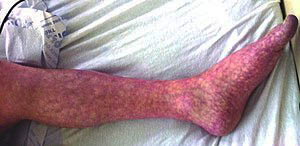
Remember:
It’s harder for us to see these signs than it is for them to feel them.
The discomfort we experience is emotional — not physical. And that’s where grace, understanding, and presence become such powerful gifts.
Other Examples:
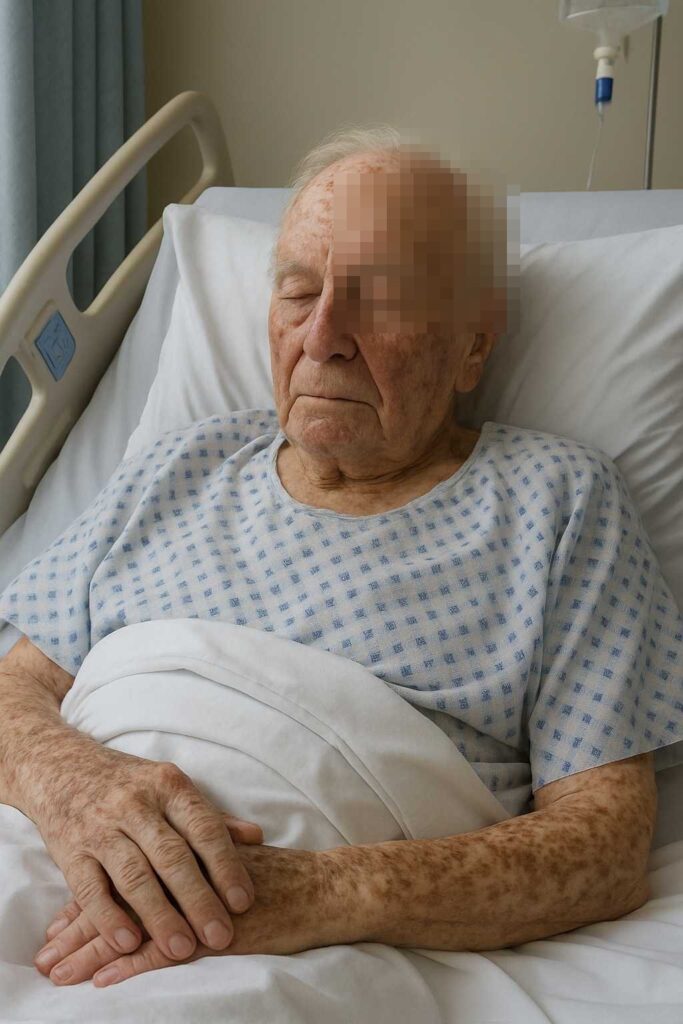
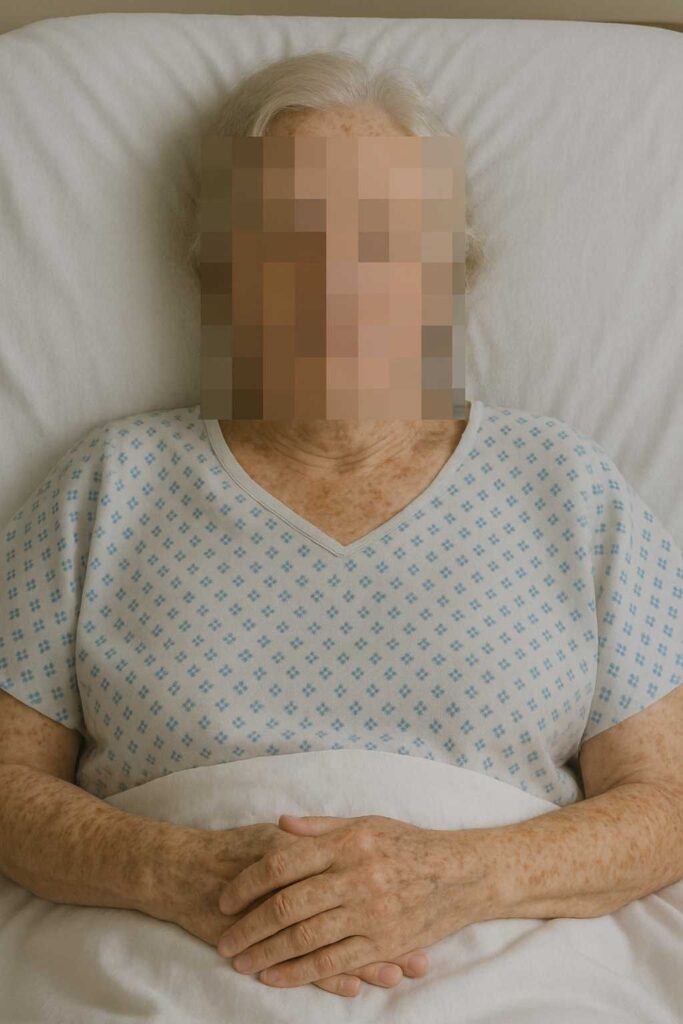
Other Common Signs That Accompany Mottling
When a loved one is nearing the end, mottled skin is just one part of the bigger picture the body paints as it says goodbye.
There are other signs too — gentle little whispers that the journey is almost complete.
Let me walk you through them the way I would if we were sitting together.
Breathing Changes
The breathing often becomes soft, irregular, almost like a sigh floating on the wind.
Sometimes there are long pauses between breaths that might make you hold your own breath in worry.
It’s all right. Their body is simply slowing down — it’s not painful, and it’s not something that needs to be “fixed.”
Extreme Tiredness or Unresponsiveness
You may notice they sleep more, or even slip into a sleep they no longer wake from.
I’ve sat with many families during these times, and I always remind them:
Even if they don’t open their eyes, they hear your voice. They feel your hand in theirs. Love carries across all distances.
Cold Hands and Feet
Those hands you once held warm might feel cool now.
It’s just the way circulation pulls back to the core.
A soft blanket, a gentle touch — that’s all that’s needed. It’s about comfort, not chasing warmth.
Little to No Urine Output
As the kidneys slow, so does everything else.
You might notice fewer trips to the bathroom or a dry catheter bag if one is in place.
It’s natural. It’s part of the body closing its chapters one by one.
Pale or Bluish Skin
Beyond the mottling, the skin may look paler, even a little bluish around the lips or fingertips.
I always tell families — don’t let the color scare you. It’s not a sign of pain. It’s a soft, natural fading, like the last light of sunset.
Restlessness or Little Movements
Sometimes, right near the end, there’s a bit of restlessness. Picking at the blankets, shifting in bed.
It’s called terminal restlessness, and it’s very common.
It doesn’t mean they’re scared — their body is simply trying to find comfort in its own way.
Your calm presence, your voice, your love — that’s the medicine here.
If there’s one thing I want you to hold onto, it’s this:
These signs aren’t something going wrong.
They’re signs that the body is doing exactly what it’s meant to do — slowing, softening, preparing for peace.
And you?
You’re doing exactly what you’re meant to do, too — loving them right through it.
Is Mottled Skin Painful?
If you’re sitting there, looking at your loved one’s mottled hands or feet, and wondering, Are they hurting? — let me offer you some comfort straight from the heart:
No, mottled skin is not painful.
It might look dramatic, even alarming if you weren’t expecting it.
But the truth is, your loved one isn’t feeling that change the way you are seeing it.
By the time mottling appears, most people are already shifting away from the physical world.
They’re spending less time feeling their body and more time drifting into that soft in-between space — the space between here and whatever lies beyond.
The skin cools, the blood flow slows, the colors bloom under the skin — but the person?
They are not in distress.
They are not crying out in pain inside.
They are simply letting go, in the most natural, gentle way the body knows.
What Families Often Feel (And It’s Okay)
I’ve seen it many times: families who feel helpless when they see mottling.
They rush for warm blankets, they panic, they wonder if they’ve missed a chance to make things better.
Please hear me:
Mottling isn’t something you caused.
It isn’t something you could have stopped.
And it isn’t something you need to fix.
What your loved one needs most right now isn’t a cure — it’s you.
Your voice.
Your touch.
Your presence.
That’s the greatest comfort medicine of all.
How Long After Mottling Does Death Typically Occur?
One of the first questions families ask when they notice mottling is, “How much time do we have left?”
And my heart aches every time, because I know what they’re really asking is, “How much longer do I get to love them here?”
The honest answer is: it depends.
Every person’s journey is a little different.
In general:
- If mottling is light and mostly on the feet or hands, there may still be a day or two left.
- If mottling spreads higher up the legs, arms, or toward the torso, the time may be much shorter — often just hours.
But this isn’t a science.
It’s a sacred unfolding, and bodies have a way of surprising us sometimes — holding on a little longer for a whispered goodbye, or slipping away quietly when the room feels full of love.
If You Notice Mottling:
Take it as a quiet invitation to be present.
Speak the words you need to say.
Sit close.
Hold their hand.
And trust that the timing, however it unfolds, will be exactly what it’s meant to be.
How Caregivers Can Support a Loved One With Mottled Skin
When you see the mottling, you might feel an instinct to do something — anything — to help.
That’s love speaking.
But often, what your loved one needs most right now isn’t action — it’s your presence.
Here’s how you can support them in these sacred final hours:
Keep Them Comfortable
There’s no need to rush around.
Simply make sure they’re lying peacefully, with soft blankets if they feel cool.
Adjust pillows if they seem restless or need to shift. Small, gentle touches mean everything now.
Speak Softly and Simply
Even if they seem unresponsive, they often hear you.
Talk to them as if they’re listening — because in many ways, they are.
Tell them you love them.
Tell them you’re there.
Tell them it’s okay to rest.
Create a Peaceful Environment
Dim the lights.
Play some quiet music if they loved music.
Light a candle if appropriate.
The goal isn’t stimulation — it’s serenity.
Hold Their Hand
Touch is a powerful language when words no longer work.
A hand on the shoulder, a kiss to the forehead — these are the ways we say, You are not alone.
Let Go of the Need to “Fix” It
Mottling isn’t something to cure.
It’s not a wound to heal.
It’s the body’s way of closing the last chapter with dignity.
Trust it. Trust them.
Take Care of Yourself, Too
Grief often starts before death — it’s called anticipatory grief.
Make sure you’re breathing, drinking water, and letting yourself rest a little when you can.
You’re not just walking beside your loved one — you’re carrying your own heart too.
Emotional Impact on Families and Caregivers
No matter how much you prepare yourself, watching a loved one’s final days unfold is one of the heaviest things you’ll ever carry.
It’s a weight on the chest, a tightness behind the eyes, a constant lump in the throat.
And if you’re feeling that right now, I want you to know: it’s normal. It’s human. It’s love, wearing its most painful face.
Dealing With Anticipatory Grief
Grieving doesn’t start at the funeral — it often starts the moment you realize the end is coming.
It creeps in quietly:
- That hollow ache when you notice how small they seem in the bed.
- That desperate wish for just one more laugh, one more smile, one more ordinary day.
- That deep, restless feeling of not wanting to let go even when you know you must.
Grief is not something to be ashamed of.
It is a sign that your love was real, and deep, and sacred.
Finding Support for Yourself
Even after the final breath, your heart will still be heavy with all the moments you shared — and all the moments you wish you had.
Lean on hospice counselors, clergy, close friends, or grief support groups.
Grieving is not a weakness.
It’s love’s way of honoring what mattered most.
When to Seek Professional Help
Even when you know what’s happening — even when you understand that mottling and other signs are normal — it’s natural to wonder, Should I call someone? Am I missing something?
Let me tell you:
Trusting your instincts as a caregiver is one of the most important things you can do.
And sometimes, reaching out for help is the greatest gift you can give — both to your loved one and to yourself.
Here’s When It’s a Good Idea to Call the Hospice Nurse or Doctor:
- If your loved one seems suddenly very uncomfortable — grimacing, restless, or showing signs of distress.
- If they develop pain that isn’t managed by the current medications.
- If breathing changes become severe or seem frightening to you.
- If you’re unsure whether a change is normal and need reassurance.
- If you simply need guidance on what to expect next.
Hospice teams are there for you as much as for the patient.
You don’t have to wait for a crisis.
You don’t need to apologize for asking questions.
You’re not “bothering” anyone by reaching out.
This is exactly what hospice care is for — to walk with you through this moment, step by step, breath by breath.
Important to Remember:
Mottling by itself — without signs of pain or distress — usually does not require emergency intervention.
It’s part of the body’s natural closing process.
But if you are worried, call.
Better to have a little extra reassurance than to sit in silent fear.
Myths and Misconceptions About Mottled Skin Before Death
Whenever I sit with families, I hear many of the same worries and myths whispered through the room.
It’s no wonder — when something looks so unfamiliar, the mind fills in the blanks with fear.
Let’s gently clear away some of those misunderstandings right now.
Myth 1: “Mottling Means Death Will Happen Immediately.”
Truth:
Mottling often signals that the end is near, but it doesn’t mean it will happen this minute — or even this hour.
Some people live for several days after mottling first appears.
The body takes the time it needs, at its own pace.
Myth 2: “Mottled Skin Is Painful or Uncomfortable.”
Truth:
The discoloration you see doesn’t cause pain.
Your loved one isn’t suffering because of the way their skin looks.
By the time mottling shows up, most people are in a peaceful, deeply restful state.
Myth 3: “If I Warm Their Hands and Feet, I Can Reverse It.”
Truth:
Mottling isn’t something that can be reversed with blankets, heaters, or massage.
It’s not about coldness — it’s about changes in circulation that happen naturally as the heart slows.
Gentle warmth for comfort is fine — but fixing the color isn’t necessary, or even possible.
Myth 4: “Something Went Wrong If Mottling Happens.”
Truth:
Nothing went wrong.
Mottling is not a failure of care.
It’s not something you missed.
It’s simply the body’s way of conserving energy, focusing inward, and preparing for the journey home.
Why Busting These Myths Matters
When you understand what’s truly happening, fear loses its grip.
You can be present — fully, lovingly — without the shadow of guilt or panic clouding these final moments.
Knowledge doesn’t erase the sadness, but it can lift the weight of fear off your shoulders.
And sometimes, that’s the light you need to carry you through.
Frequently Asked Questions (FAQs)
How long can someone live after mottling starts?
It truly depends on the person.
Some may pass within a few hours, while others hold on for a day or two.
Mottling tells us the body is slowing, but it doesn’t give us a precise clock.
Stay close. Speak from your heart. Let the moments unfold as they are meant to.
Is mottling always a sign that death is near?
In the context of terminal illness and hospice care, yes — mottling is usually a sign that the end is approaching.
But outside of end-of-life situations, mottling can also happen temporarily due to cold temperatures or circulation problems.
When you’re under hospice care and see mottling, it almost always means the journey is nearly complete.
Can young people experience mottled skin before death?
Yes, they can.
While it’s more common in the elderly, mottling can happen to younger people who are critically ill or near death as well.
It’s part of how the body naturally prepares, regardless of age.
Should we call family members when mottling appears?
If there are people who want to say their goodbyes, yes, this is a tender time to call them.
Remind them there’s no need for panic — just presence.
This is a moment for hands held, memories shared, and love spoken aloud.
Can mottling be prevented?
No — and it’s not something that needs to be prevented.
Mottling is not a mistake or a problem to solve.
It’s simply part of the body’s graceful letting go.
Your role isn’t to stop it — your role is to honor it with your love and care.
Final Thought on Questions:
If you’re ever unsure about something you see, ask.
Hospice nurses, doctors, even volunteers like me — we’re here to walk beside you.
There are no silly questions when you’re walking through sacred moments like these.
Final Thoughts: Understanding, Compassion, and Dignity
If you’ve read this far, my heart is with you.
You are walking through one of life’s most sacred, heartbreaking, and beautiful journeys — witnessing a loved one’s final chapter.
And through every change you see — mottled skin, slowing breath, quiet hands — one truth remains stronger than anything else:
Love does not fade. It does not weaken. It carries. It endures.
Understanding what’s happening doesn’t take away the ache.
But it can lift the weight of fear.
It can help you sit at their bedside, not with panic or helplessness, but with calm compassion — a steady lighthouse in the storm.
Three Things I Hope You Carry With You:
- Mottling is normal. It’s not a sign of suffering. It’s the body’s graceful way of letting go.
- Your presence matters more than anything. You don’t have to fix or fight anything. Just be there.
- This is sacred ground. You are honoring them — walking them home with dignity, gentleness, and love.
A Final Whisper From My Heart to Yours:
When your loved one takes their final breath, know this:
You were their comfort.
You were their anchor.
You were their safe place to let go.
And that is one of the greatest acts of love any human being can give.
You have done — and are doing — beautifully.
Share This Article:




